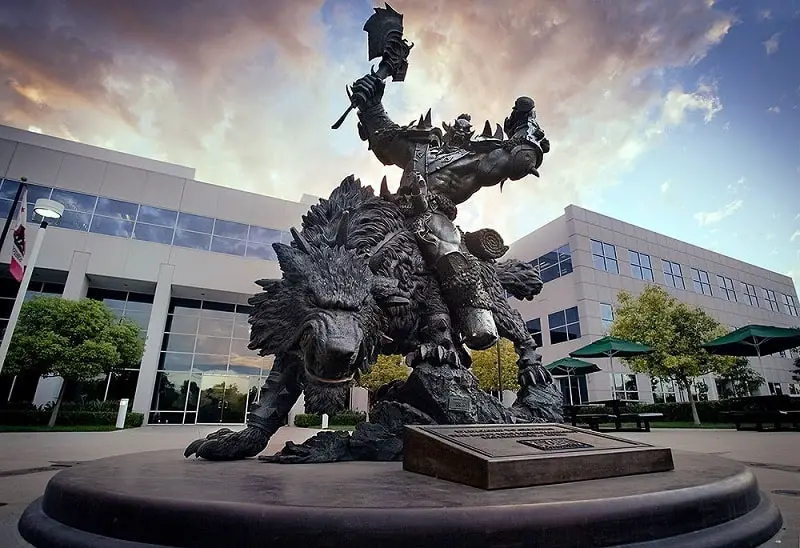Salary, Job Description, How To Become One, and Quiz
.jpg)
Narrative Designers
Narrative Designers are hired to design or oversee the narrative elements of a video game. They are responsible for ensuring that the video game has an engaging storyline that keeps players playing.
Table of contents
Have you played a video game and thought that you could write better dialogue? The dialogue is an important part of any video game. It helps keep players interested in the story. However, poorly written dialogue can take away from the playing experience.
Along with dialogue, games tend to feature overarching plots with multiple sub-plots and dozens of quests. Keeping track of all the dialogue, plot lines, and narrative elements is a challenging job, which is where a Narrative Designer comes in. The Narrative Designer is a unique role, as they help video game companies craft better stories.
What they do
Narrative Designers are hired to design or oversee the narrative elements of a video game. They are responsible for ensuring that the video game has an engaging storyline that keeps players playing.
Collaborate on the Storyline for Video Games
Narrative Designers who work for small video game developers may receive complete freedom when crafting the storyline for a game. At a large video game developer, the Narrative Designer has less control. They collaborate on the storyline with a team of professionals.
For example, the Lead Game Designer or the Game Producer may develop the plot. The Narrative Designer then works on the individual narrative elements of the plot, helping to expand the world-building of the game and flesh out the story.
Map Out the Narrative Features of the Game
Video games often have expansive storylines with many branching narrative elements. The player’s choices influence the outcome of the story and future narrative features. It is the Narrative Designer’s job to ensure that these elements work together to create a cohesive story.
Narrative Designers may create a map of the main narrative elements. The map is often created using specialized software. They may create a branching tree with multiple story paths or use a diagram to illustrate all the potential outcomes of each scene.
Write the Dialogue and Text for the Game
Narrative Designers write the dialogue and text that appears in video games. They write the dialogue options that users can select from along with the dialogue spoken by NPCs. The goal of the Narrative Designer is to keep the player engaged, which means considering all the potential outcomes of a particular dialogue option.
Video games may also contain in-game text. For example, the character may pick up a book and be able to read excerpts. The Narrative Designer would likely be the person responsible for writing the excerpts.
Narrative Designers are also on hand to rewrite dialogue during the development process. Developers may change an aspect of the game that impacts existing narrative elements. This requires the Narrative Designer to make changes and ensure that the continuity of the story remains intact.
Monitor the Dialogue Recording Sessions
The Narrative Designers may be present during the dialogue recording sessions. They may offer feedback on the delivery of the lines. For example, a voice actor may misinterpret a character’s emotion or motivation for a scene. The Narrative Designer may offer more clarity.
What is the job like
Pros
You Get to See Your Stories Become Part of a Larger Project
Narrative Designers often enjoy the process of collaborating on video games and watching their dialogue and plots become integrated into a complex game.
You Work with a Diverse Range of People
Narrative Designers may work with different individuals on almost every project. You are constantly meeting new people with a diverse range of skills, cultures, and opinions.
You May Find Work in Other Industries
Narrative Designers occasionally use their skills to find work in other industries. You may decide to write novels or offer your services as a freelance writer for major publications.
You Do Not Need Any Special Certification
Narrative Designers often have a Bachelor’s Degree due to the competitive nature of this job, but they do not need to complete any specific training courses or earn certifications.
Cons
There Are Lots of Responsibilities
Narrative Designer is often a senior role with lots of responsibilities and duties, which can occasionally make this job stressful.
Work Can Be Tedious
Junior Narrative Designers are typically tasked with writing dialogue and developing non-player characters (NPCs), which some individuals find boring and repetitive.
Where they work




Narrative Designers often work for video game development companies and publishers in the video game industry. Marketing and advertising agencies may employ Narrative Designers for complex marketing campaigns with a narrative focus, such as interactive content.
Narrative Designers may also find work at motion picture studios. Narrative Designer positions are also occasionally available at software development companies.
How to become one
Step 1: Take English and Computer Classes
Study English and computers in high school to develop the basic skills needed for this job. Narrative Designers need a firm grasp of the English language and a basic understanding of computers.
Step 2: Earn a Bachelor’s Degree
A Bachelor’s Degree is considered the minimum educational requirement for Narrative Designers due to the limited availability of jobs in this field.
Step 3: Get an Entry-Level Job in the Video Game Industry
Narrative Designers need to get their foot in the door by applying for entry-level jobs. Before qualifying for the Narrative Designer position, you may need several years of experience. Many Narrative Designers start as Creative Writers, Junior Writers, or Assistant Narrative Designer.
Step 4: Build a Portfolio
Build a portfolio to demonstrate your narrative design skills. A portfolio is the main thing that employers look at when considering a candidate. Your portfolio should include all professional projects that you have completed along with any personal projects that you are proud of. Narrative Designers can demonstrate their skills by completing personal projects using narrative design tools, such as Twine.
Step 5: Apply for Narrative Designer Jobs
After building a portfolio and gaining experience, start applying for Narrative Designer jobs. Finding a Narrative Designer job often requires a proactive approach. You may need to apply at multiple studios and follow up with your applications.
Should you become one
Best personality type for this career
People with this personality likes to work with designs and patterns. They prefer activities that require self-expression and prefer work that can be done without following a clear set of rules.
You can read more about these career personality types here.
Narrative Designers are highly creative individuals as they need to craft interesting stories that keep players engaged. Narrative Designers are also typically good communicators as they collaborate on the development of the story with other video game professionals.
Narrative Designers are often empathetic, as empathizing with the players and characters allows them to write more compelling stories. A successful Narrative Designer should also be studious due to the need to study language and develop a large vocabulary.
Take this quiz to see if this is the right career for you.
Don’t know which career to pursue?
Take the career quiz to find careers that match your personality type.
Take The Career Quiz
.jpg)
.jpg)
.jpg)
.jpg)
.jpg)
.jpg)
.jpg)
.jpg)
.jpg)
